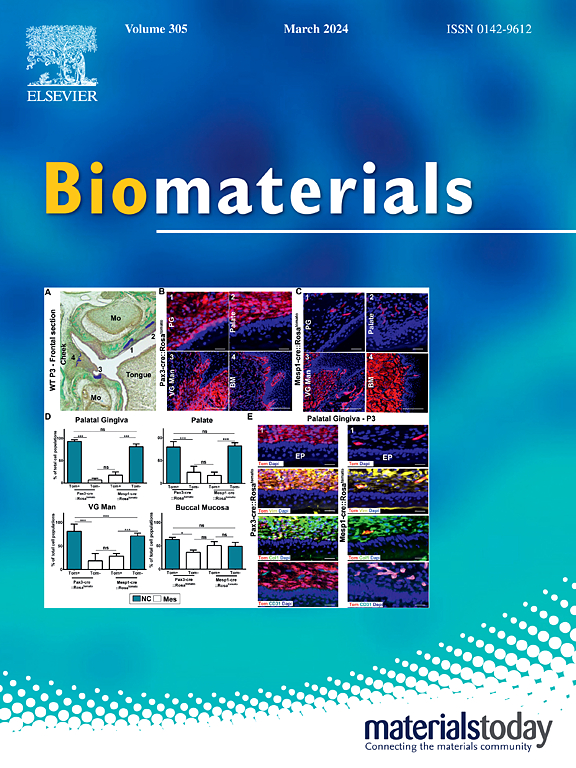可注射的天然银耳衍生水凝胶,用于逆转铁中毒介导的骨质疏松微环境失衡和促进骨再生
IF 12.8
1区 医学
Q1 ENGINEERING, BIOMEDICAL
引用次数: 0
摘要
骨质疏松性骨缺损由于自身修复能力有限,构成了全球性的健康困境。铁超载引起的铁下垂是骨质疏松症的一个重要病理特征,它会消耗成骨细胞并扰乱骨代谢。受天然银耳多糖(TP)的启发,我们开发了一种可注射的复合水凝胶(OGP@DTrep),能够通过双重机制抑制细胞铁下垂。在加入甲基丙烯酸化TP、氧化TP、硫酮(TK)和成骨生长肽(OGP)后,OGP@DTrep显示出一系列的生物活性,包括智能活性氧(ROS)反应和药物释放、免疫调节、促进血管生成和抑制破骨细胞活性。更重要的是,由于TP中的羧基和糖单元的羟基分别与游离铁离子形成盐桥作用和氢键键,OGP@DTrep可以有效地螯合微环境中过量的铁离子。此外,OGP@DTrep增加细胞内抗氧化能力,抑制成骨细胞铁下垂,促进骨基质分泌。在骨质疏松性骨缺损大鼠模型中,它能逆转铁代谢失衡,恢复骨量和骨结构。本研究提出了一种具有ROS反应和铁代谢调节等多种活性的天然衍生生物材料,为治疗骨质疏松性骨缺损和其他骨疾病提供了新的视角。本文章由计算机程序翻译,如有差异,请以英文原文为准。
Injectable natural Tremella-derived hydrogel for reversing ferroptosis-mediated osteoporotic microenvironment imbalance and promoting osteoregeneration
Osteoporotic bone defects constitute a global health predicament due to their restricted self-repairing capacity. Ferroptosis arising from iron overload represents a crucial pathological characteristic of osteoporosis, depleting osteoblasts and disturbing bone metabolism. Inspired by natural tremella polysaccharide (TP), we developed an injectable composite hydrogel (OGP@DTrep) capable of inhibiting cell ferroptosis via dual mechanisms. Following the incorporation of methacrylated TP, oxidized TP, thioketal (TK), and osteogenic growth peptide (OGP), OGP@DTrep exhibits a range of biological activities including intelligent reactive oxygen species (ROS) response and drug release, immunomodulation, promotion of angiogenesis, and inhibition of osteoclast activity. More importantly, since the carboxyl group in TP and the hydroxyl group of the sugar unit can form salt bridge interactions and hydrogen bond linkages with free iron ions, respectively, OGP@DTrep can efficiently chelate excessive iron ions in the microenvironment. Moreover, OGP@DTrep increases the intracellular antioxidant capacity, inhibits osteoblast ferroptosis, and enhances bone matrix secretion. In a rat model of osteoporotic bone defects, it reversed iron metabolism imbalance, restoring bone mass and microstructure. This study presents a naturally derived biomaterial with multiple activities, such as a ROS response and iron metabolism regulation, offering a new perspective for treating osteoporotic bone defects and other bone diseases.
求助全文
通过发布文献求助,成功后即可免费获取论文全文。
去求助
来源期刊

Biomaterials
工程技术-材料科学:生物材料
CiteScore
26.00
自引率
2.90%
发文量
565
审稿时长
46 days
期刊介绍:
Biomaterials is an international journal covering the science and clinical application of biomaterials. A biomaterial is now defined as a substance that has been engineered to take a form which, alone or as part of a complex system, is used to direct, by control of interactions with components of living systems, the course of any therapeutic or diagnostic procedure. It is the aim of the journal to provide a peer-reviewed forum for the publication of original papers and authoritative review and opinion papers dealing with the most important issues facing the use of biomaterials in clinical practice. The scope of the journal covers the wide range of physical, biological and chemical sciences that underpin the design of biomaterials and the clinical disciplines in which they are used. These sciences include polymer synthesis and characterization, drug and gene vector design, the biology of the host response, immunology and toxicology and self assembly at the nanoscale. Clinical applications include the therapies of medical technology and regenerative medicine in all clinical disciplines, and diagnostic systems that reply on innovative contrast and sensing agents. The journal is relevant to areas such as cancer diagnosis and therapy, implantable devices, drug delivery systems, gene vectors, bionanotechnology and tissue engineering.
 求助内容:
求助内容: 应助结果提醒方式:
应助结果提醒方式:


